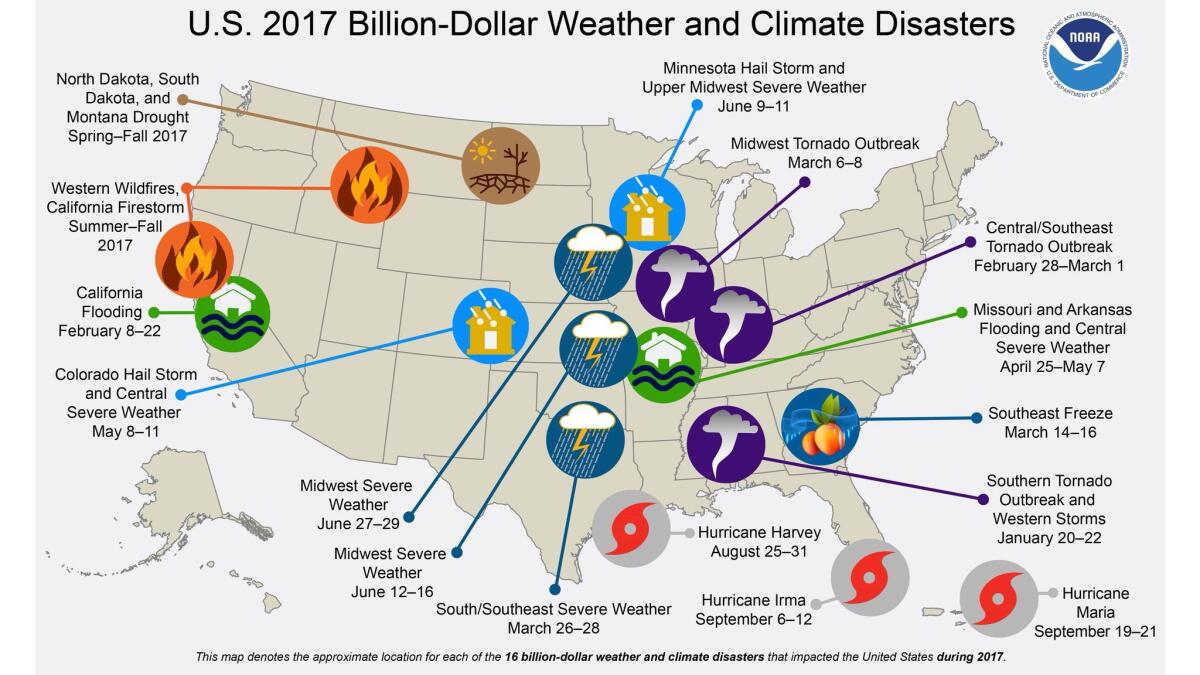2017 was a hot and disaster-filled year for the United States, NOAA says
- Share via
The year 2017 was the third-warmest on record for the United States, and featured a pileup of weather and climate disasters that cost the nation a record-breaking $306 billion, according to the National Oceanic and Atmospheric Administration.
The preliminary data released by NOAA’s National Centers for Environmental Information serve as another indication that climate change shows little sign of relenting — with troubling implications for the risk of extreme weather and climate events in the future.
“Clearly, 2017 underscores what we’ve seen in the past with regard to better mitigating our risk and enhanced frequency of weather and climate extremes,” Adam Smith, an applied climatologist at NOAA, said at a briefing Monday.
Here are some highlights from the new NOAA report.
Temperature
The results put annual average temperatures for the lower 48 states at 54.6 degrees Fahrenheit, 2.6 degrees higher than the average for the 20th century. That places 2017 in the middle of the nation’s top five hottest years since record-keeping began in 1895. All five top years — including the country’s warmest, 2016 — have taken place since 2006.
With heat hitting parts of the Southwest, the southern Plains and the Southeast, several individual states saw their highest-ever annual temperatures: Arizona, New Mexico, Georgia, North Carolina and South Carolina. Thirty-two states, including Alaska, had annual temperatures that ranked in their top-10 warmest. Some areas, such as part of the interior Northwest, saw below-average temperatures.
“Not everywhere was warm, but when we do average those temperatures across the entire U.S., it ranked as the third-warmest on record,” Jake Crouch, a NOAA climate scientist, said at the briefing. In fact, every state in the lower 48 plus Alaska had above-average annual temperatures for the third year in a row.
Last year also marks the 21st year in a row that the average annual temperature has been higher than the 1901-2000 average, Crouch said.
Extremes
The year 2017 also included 16 weather and climate disasters with losses exceeding $1 billion each — two inland floods, one freeze event, eight severe storms, three tropical cyclones, as well as drought and wildfire, Smith said.
Keep in mind, the average annual number of events from 1980 to 2017 was just 5.8 per year, and the annual average for the most recent five years (that is, 2013 to 2017) was 11.6 events. Climate scientists have long suggested that climate change may lead to a higher risk of certain extreme weather and climate events.
While those 16 “billion-dollar” events tied 2017 with 2011 for the highest number in a single year, 2017 was by far the most expensive, racking up total costs of $306.2 billion. The new record far outpaced the previous record cost of $214.8 billion in 2005, a year that suffered Hurricanes Rita, Wilma, Dennis and Katrina. In fact, 2017 was a record year for hurricane costs alone — some $265 billion in losses out of the total $306 billion. Those included Hurricanes Harvey, Irma and Maria, which joined Hurricanes Sandy (2012) and Katrina (2005) as the top-five costliest hurricanes in U.S. history.

Regional highlights
Last year was also the most expensive wildfire season, with a price tag of $18 billion, Smith said, tripling the cost of the previous wildfire record from 1991. Those numbers include the massive Northern California fires this past fall as well as the blazes that burned through Southern California in December.
Last year was also the country’s 20th wettest on record, as well as the fifth year in a row that had above-average precipitation. The year started with a very wet winter for the Northwest, but ended with the ninth-driest December on record. This helped lay the deadly groundwork for the fires that scarred California, the scientists pointed out.
“The really wet winter there allowed vegetation to flourish, and then during the typically dry summer and autumn period that vegetation dried out — providing ample fuels for wildfires,” Crouch said. “It’s been a pretty devastating year out West, in that respect.”
What’s to blame
The scientists could not say how much of the high costs of this year’s major disasters was due to risks associated specifically with global warming and climate change, and how much was due to the fact that humans tend to live in cities and build vital infrastructure along coasts, rivers and other high-risk zones.
“Both the economists and the physical scientists retrospectively will look at that,” said Deke Arndt, chief of the monitoring section for NOAA’s National Centers for Environmental Information. “But those kind of happen at the speed of science.”
Follow @aminawrite on Twitter for more science news and "like" Los Angeles Times Science & Health on Facebook.
MORE IN SCIENCE:
Gene therapy offers long-term treatment for mice with diabetes
Even if you don't know you're sick yet, your face will give you away




